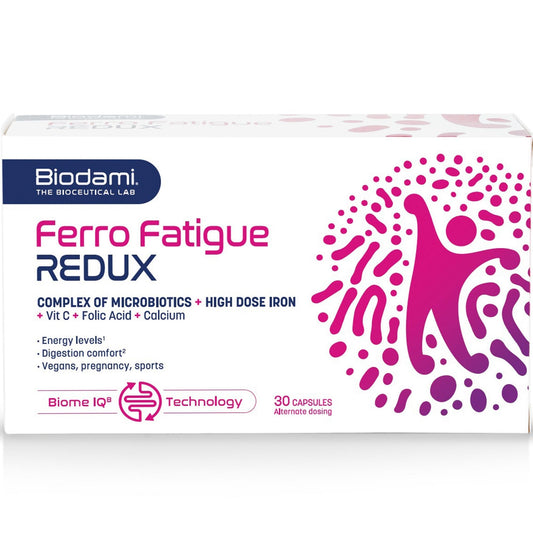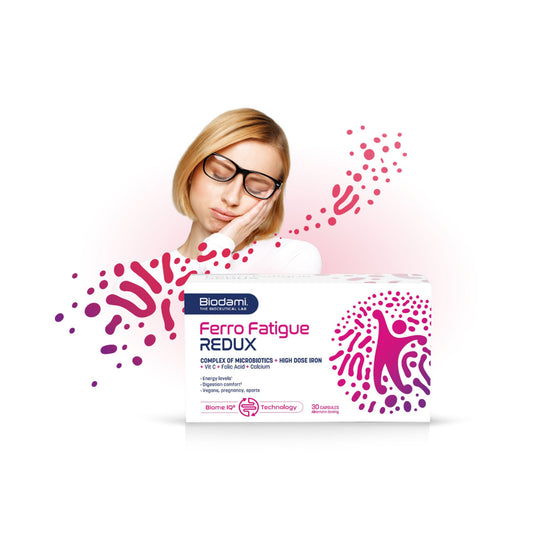WHAT IS IRON?
Iron is an element that is biologically essential to humans. It is necessary for immune responses, oxidative metabolism, physical growth and neurological functioning. It is a necessary component of a number of proteins including enzymes, hemoglobin and myoglobin [1,2,3]. Hemoglobin is a protein in the red blood cells that carries oxygen from the lungs to the body and myoglobin is a protein that provides oxygen to the muscles. This oxygen carrying mechanism in our body is one of the most vital function of iron. For different phases in life, there are different recommended daily intake levels of iron. In order to maintain healthy iron levels, these recommended dietary intake (RDI) levels should be followed.
IRON SOURCES AND DISTRIBUTION IN THE BODY
Our body does not make iron so we need to get our iron from the foods we eat. Iron can be found in (red) meats, with high amounts in animal liver, egg yolk, fish and in plant foods such as nuts and spinach.
Once absorbed, iron is delivered to the tissues via transferrin, a special transporter protein [4]

-
75% of the iron absorbed in the body goes to the formation of hemoglobin and red blood cells.
-
10-20% is stored in iron stores called ferritin- iron needs to be stored and transported via specialized proteins to keep iron in the soluble non toxic form.
-
5-15% is used for other processes in the body.
Because iron is reactive and toxic in excess, our bodies have been endowed with elegant mechanisms to regulate our iron stores, keeping iron in a healthy physiological and optimal range [5,6,7]. But once iron is absorbed, there is no mechanism in the body that allows us to get rid of iron except through small amounts of dead cells or when we bleed.
Our bodies regulate excess iron by keeping sufficient storage in specialized proteins (called ferritin), and by reutilizing body iron thereby limiting its uptake from the environment. Ultimately the amount of iron absorbed will very much depend on the amount that is circulating in the body and the amount of iron we have in storage [5,6].
WHAT IS IRON DEFICIENCY?
Despite the abundance of iron, it is still the most common form of malnutrition in the world [8]. So much so that it affects not only people in low and middle-income countries but is very much prevalent in high income countries where other forms of malnutrition have been eliminated.
Iron deficiency affects 2 billion people in the world!
50% of anemia* cases are caused by iron deficiency.
*Anaemia is a condition in which the number of red blood cells or the hemoglobin concentration within them is lower than normal. World Health Organization–recommended cut-off for anemia (Hb ,13 g/dL in males, ,12 g/dL in females, ,11g/dL during pregnancy)
With iron being used for oxygen transport, iron deficiency, even if mild may leave you feeling very tired and even short of breath. These symptoms are proportional to the degree of iron deficiency [2]. In turn, fatigue is associated with significant physical, emotional, psychological, and social consequences, with virtually every aspect of daily life being affected. Iron deficiency with or without anemia has also been found to be associated with reduced muscle myoglobin content, reducing muscle strength and endurance [9]
CAUSES OF IRON DEFICIENCY
The causes of iron deficiency can vary. Vegetarians and vegans are more likely to be iron deficient. For some, it is genetic, for others due to chronic gastrointestinal issues such as Crohn’s disease, Ulcerative Colitis and Celiac disease and for others there is simply a depletion of iron stores because all the iron is used up or is lost through significant blood loss, like during menstruation. In other words, your diet, chronic blood loss, pregnancy and vigorous exercise can cause iron deficiency.
Despite iron being available in foods, it is very poorly absorbed. This goes back to the way our bodies protect us from the toxic effects of iron (eg. liver and heart damage) by tightly regulating it [10].
For those with iron deficiency or at risk thereof such as menstruating women, pregnant women, vegetarians, vegans and athletes, it becomes beneficial to supplement their diet with additional iron supplements, partly because - depending on the iron foods you consume-your iron absorption from food is too low. At best up to 13% [11,12]. Read this blog for more info on who can benefit from iron supplements.
IRON AND THE GUT MICROBIOME
The gut and our microbiome play a big role in iron absorption. First of all, the absorption of dietary iron occurs in the duodenum and proximal jejunum and depends heavily on the physical state of the iron atom. At physiological pH, iron exists in the oxidized, ferric (Fe3+) state.
To be absorbed, iron must first go through an important reduction step. Iron must be in the ferrous (Fe2+) state or bound by a protein such as heme. Read our blog on the detailed cellular mechanisms here.
Iron supplements are typically supplemented in different salt forms (as ferrous salts like the traditional ferrous sulfate, ferrous fumarate and ferrous gluconate) but these forms may differ in their bioavailability. Bioavailability means the ability of the substance to be absorbed (through the intestines).Read more here about the bioavailability of the iron used in Ferro Fatigue Redux.
And because absorption is the key regulation mechanism of iron in our bodies, it is important to choose the right salt form that will give you better bioavailability especially for those iron deficient who need to supplement their iron in significant levels. Unfortunately, this poor absorption, especially of the less bioavailable ferrous salt can cause gut irritation. As mentioned previously, iron is a reactive element and when released into the digestive tract, it oxidizes, creating free oxygen radicals that cause inflammation, disturb the microbiome or can irritate the stomach lining . Ultimately this leads to adverse effects that iron supplements are well known for. Side effects that may be felt are: constipation, diarrhea, heartburn, nausea, and epigastric pain, which may affect up to 20% of patients and limit compliance to the different iron formulations [13]. When choosing the type of iron to supplement your diet, it would be beneficial to make sure you choose iron forms that have been shown a.) to be better absorbed than other traditional salts b.) to not cause any gut irritation.
Likewise, pathogenic bacteria (the bacteria that can make you ill) that reside in the gut thrive on iron for their survival but normally are kept at bay due to the competition for iron by the body and other bacteria. When high doses of iron are supplied, these pathogens get all the iron they need to thrive, which can cause an imbalance of good and bad bacteria (dysbiosis)[14].
Iron is absorbed in the duodenum and if the integrity of this section of the gut is destroyed, the ability to absorb iron is reduced. Therefore, a harmonized balance in the gut composition is essential for iron homeostasis. A probiotic strain such as Lactobacillus fermentum, a probiotic found in human microbiota, exhibits a remarkable ferric-reducing activity. This means that is able to reduce iron from Fe3+ (the unabsorbable form) to Fe2+ (the form it needs to be to be absorbed). This probiotic strain is able to produce a special metabolite that can increase absorption through the DMT1 transporters (Read here for more information) from the gut cells (enterocytes). Likewise, a systematic review has also demonstrated the use of another Lactobacillus strain Lactobacillus plantarum LP299v in its ability to improve non-heme iron absorption in active Caucasian Europeans [15].
KEY TAKEAWAYS
-
Iron is biologically essential and for the most part, is the nutrient that will deliver oxygen to our cells and tissues.
-
Our bodies have a mechanism to regulate iron in the body: it is mostly regulated through limiting iron absorption.
-
Absorption of iron from food is low, so iron-deficient individuals can benefit from supplements. But selecting the right type of iron supplements is important to make the most of the bioavailability without gut irritation. These should be part of the checklist for your iron supplement.
-
Excess iron will irritate the gut, can cause an overgrowth of bad bacteria and disturb the natural balance of the microbiome.
-
The microbiome composition in the gut is also important because particular probiotic strains such as Lactobacillus fermentum and Lactobacillus plantarum can affect the efficiency of iron absorption.
-
Therefore, understanding probiotic strains and their capacity to convert unavailable iron into its available form, or to create metabolites that indirectly increase iron absorption in the gut is essential. Adding these strains to the diet can be beneficial for iron uptake and for preserving the natural balance of the microbiome.
Sophie Cochez
Sophie holds a master degree in medical biology, with particular focus on microbiology and biotechnologies. Passionate about health sciences, she had her first professional experience in a clinical research center, a CNRS unit (Centre national de la recherche scientifique) to develop her master thesis on "The use of antibody arrays to analyze human proteomes of cancer - and its perspective of application for breast cancer diagnosis". CNRS FRE 2230
References:
1. Institute of Medicine (US) Panel on Micronutrients. Dietary Reference Intakes for Vitamin A, Vitamin K, Arsenic, Boron, Chromium, Copper, Iodine, Iron, Manganese, Molybdenum, Nickel, Silicon, Vanadium, and Zinc. Washington (DC): National Academies Press (US); 2001. Available from: https://www.ncbi.nlm.nih.gov/books/NBK222310/ doi: 10.17226/10026
2. Houston BL, Hurrie D,Graham J, et al. Efficacyof iron supplementation on fatigue and physical capacity in non-anaemic irondeficient adults: a systematic review of randomisedcontrolled trials. BMJ Open 2018;8:e019240. doi:10.1136/ bmjopen-2017-019240
3. Aggett PJ. Iron. In: Erdman JW, Macdonald IA, Zeisel SH, eds. Present Knowledge in Nutrition. 10th ed. Washington, DC: Wiley-Blackwell; 2012:506-20.
4. Abbaspour N, Hurrell R, Kelishadi R. Review on iron and its importance for human health. J Res Med Sci 2014;19:164-74.
5. Anderson J. G and Frazer D.M. Current Understanding of Iron homeostasis. Am J Clin Nutr 2017;106(Suppl):1559S–66S.2017,
6. Camaschella, Clara, Antonella Nai, and Laura Silvestri. "Iron metabolism and iron disorders revisited in the hepcidin era." Haematologica 105.2 (2020): 260.
7. Gasche, C., Lomer, M. C., Cavill, I., & Weiss, G. (2004). Iron, anaemia, and inflammatory bowel diseases. Gut, 53(8), 1190–1197. https://doi.org/10.1136/gut.2003.035758
8. World Health Organization. (2016). Guideline: Iron supplementation
9. EFSA NDA Panel (EFSA Panel on Dietetic Products, Nutrition and Allergies), 2015. Scientific Opinion on Dietary Reference Values for iron. EFSA Journal 2015; 13 ( 10):4254, 115 pp. doi:10.2903/j.efsa.2015.4254
10. Ems T, St Lucia K, Huecker MR. Biochemistry, Iron Absorption. [Updated 2022 Apr 21]. In: StatPearls [Internet]. Treasure Island (FL): StatPearls Publishing; 2022 Jan-. Available from: https://www.ncbi.nlm.nih.gov/books/NBK448204/
11. Stoffel, N. U., Cercamondi, C. I., Brittenham, G., Zeder, C., Geurts-Moespot, A. J., Swinkels, D. W., Moretti, D., & Zimmermann, M. B. (2017). Iron absorption from oral iron supplements given on consecutive versus alternate days and as single morning doses versus twice-daily split dosing in iron-depleted women: two open-label, randomised controlled trials. The Lancet. Haematology, 4(11), e524–e533. https://doi.org/10.1016/S2352-3026(17)30182-5
12. Abbaspour N, Hurrell R, Kelishadi R. Review on iron and its importance for human health. J Res Med Sci 2014;19:164-74.
13. Cancelo-Hidalgo MJ, Castelo-Branco C, Palacios S, et al. Tolerability of different oral iron supplements: a systematic review. Current Med Research & Opinion. 2013;29(4): 291-303. http://www.ncbi.nlm.nih.gov/pubmed/23252877
14. Rusu, I. G., Suharoschi, R., Vodnar, D. C., Pop, C. R., Socaci, S. A., Vulturar, R., Istrati, M., Moroșan, I., Fărcaș, A. C., Kerezsi, A. D., Mureșan, C. I., & Pop, O. L. (2020). Iron Supplementation Influence on the Gut Microbiota and Probiotic Intake Effect in Iron Deficiency-A Literature-Based Review. Nutrients, 12(7), 1993. https://doi.org/10.3390/nu12071993
15. Vonderheid, S.C.; Tussing-Humphreys, L.; Park, C.; Pauls, H.; Hemphill, N.O.; LaBomascus, B.; McLeod, A.; Koenig, M.D. A Systematic Review and Meta-Analysis on the Effects of Probiotic Species on Iron Absorptionand Iron Status. Nutrients 2019, 11, 2938







